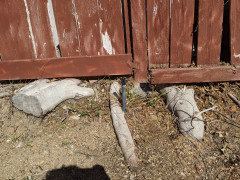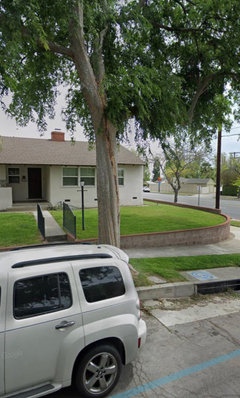Ficus Nitida (Retusa) Hedge spacing advice please.
aptruncata
12 years ago
Featured Answer
Sort by:Oldest
Comments (90)
stanofh 10a Hayward,Ca S.F. bay area
8 years agoEast MB
8 years agoRelated Discussions
Ficus between retaining wall and pool
Comments (4)You are correct that Ficus (Ficus nitida) is considered to have an agressive root system. They are notorious for having roots that lift sidewalks, fence footers and even home foundations. A good rule of thumb to follow is to allow enough space in a planting area to accommodate the tree at maturity. In other words, a tree like Ficus nitida generally has a canopy that grows to about 20 - 30 feet at maturity and you would want to allow this much space in your planting bed. You would never want to plant this tree closer than 10 - 15 feet from a fence or home. People often forget that a tree's root system will extend 1 1/2 - 4 times the diameter of the canopy in the surrounding soil and don't allow enough room. Plus, this tree is vulnerable to frost damage (you might have seen all the brown trees in the Phoenix valley lately.) There are lots of other choices available for the space you describe as well as a list of recommended plants around pools. Look for the FREE booklet, Landscape Plants for the Arizona Desert which is sometimes available at local nurseries. Check this website for other locations http://www.amwua.org/conservation/landscape_plants.htm Here is a link that might be useful: Pool Friendly Plants...See MoreBest Plant For Security/ Screen Hedge in Full Sun
Comments (43)Do not worry about Oleanders toxicity. my aunt has been a veterinarian in PHX for 30 years and has never seen or heard of a case of oleander poisoning. We decided against Oleanders because of the proximity to the pool, they are very messy. We instead planted a Japanese Privet hedge, total of 65 5-gal spaced 3 ft. The only main drawback is the water consumption during their first summer. Each received 5 gallons of water 5x/week. Heavy water schedule on a reliable drip is an absolute must in their first summer. Otherwise they will fry. Even with consistent deep watering, about 20% did not survive. Another tip that will greatly enhance survival and thrive is proper soil amendment. Privets do not like high PH soil (too much salt) which is very prevalent in AZ soil. Prior to planting, treat the soil w a sulfur product. this will loosen the soil and allow for maximum nutrition uptake. Ensure to continually treat the plants w products that will lower PH levels. Many synthetic fertilizers will increase PH, so look for a local organic compound meant for trees and shrubs. Our hedge has grown 4 ft in 2 years. and will grow faster now that they're established. Good luck!...See MoreNeed advice on planting rest of a hedge
Comments (4)will the tree/shub learn not to send branches toward the fence :) ? ==>>> only if you teach it with pruning shears ken ps: inanimate objects can not learn ... but they can be trained.. thru aggressive pruning ......See MoreHELP! I Inherited 20 Ficus Benjamina trees. - Los Angeles
Comments (29)Thanks so much parker25mv! Looks like we're both on the same page. I'm not planning on planting them in the ground, and I agree that they're too dominant in LA right now. When I was trying to find a suitable screen plant I read through all of the ficus discussion on here and decided against them. Then these fell into my lap, which opens up budget for native CA plants elsewhere so I'm trying to make lemonade. I'll leave them in the half-barrels, but I'm also open to any suggestions to make them healthier. Root pruning has been suggested above, which I'm looking into now. Thanks!...See Moreswgomez78
8 years agogyr_falcon
8 years agoDebora Kleven
8 years agoeblc1980
7 years agostanofh 10a Hayward,Ca S.F. bay area
7 years agolast modified: 7 years agoParadise Nursery
7 years agoAngelique H
6 years agoMark P
6 years agoJonathan Ruddy
6 years agoBrad Sampson
5 years agoFramces Mcgregor
5 years agostanofh 10a Hayward,Ca S.F. bay area
5 years agoAlma
4 years agogyr_falcon
4 years agoAlma
4 years agoEd Vazquez
4 years agoHU-210721065
4 years agosdsunn
4 years agoCasey Spaulding
4 years agomsbooklady
3 years agomsbooklady
3 years agosdsunn
3 years agoEd Vazquez
3 years agosdsunn
3 years agoS M
3 years agoS M
3 years agolast modified: 3 years agoS M
3 years agoS M
3 years agoS M
3 years agoshinedale
3 years agolast modified: 3 years agoMatthew E Jacobson
3 years agoS M
3 years agoS M
3 years agoHU-742135765
3 years agolast modified: 3 years agoEd Vazquez
3 years agostanofh 10a Hayward,Ca S.F. bay area
3 years agoMark P
3 years agoLindsay Donaldson
3 years agoLindsay Donaldson
3 years agoLindsay Donaldson
3 years agostanofh 10a Hayward,Ca S.F. bay area
3 years agoHU-687143519
3 years agoLUBO68
last yearSanjay Singh
10 months agoNathalie G
10 months agomsbooklady
10 months agoHU-307900676
6 months ago
Related Stories

GARDENING GUIDES9 Low-Growing Hedges That Make Good Neighbors
Define garden areas or borders without blocking the view, with these evergreen shrubs that take kindly to trimming
Full Story
SIDE YARD IDEASNarrow Trees for Tight Garden Spaces
Boost interest in a side yard or another space-challenged area with the fragrance and color of these columnar trees
Full Story
GARDENING AND LANDSCAPINGGrow a Lush Privacy Screen
No need to wait forever for patio privacy the green way. These 10 ideas will get your screening up and running in no time
Full Story
LANDSCAPE DESIGNBoxwood Alternatives Bring the Chelsea Flower Show to You
Don’t let box blight limit your plans to borrow garden design ideas from the renowned British event
Full Story
GARDENING FOR BUTTERFLIESGarden for Wildlife to Reap Rich Rewards
When you plant with animals and insects in mind, you make gardening easier, the planet healthier and yourself more present
Full Story
















shinedale